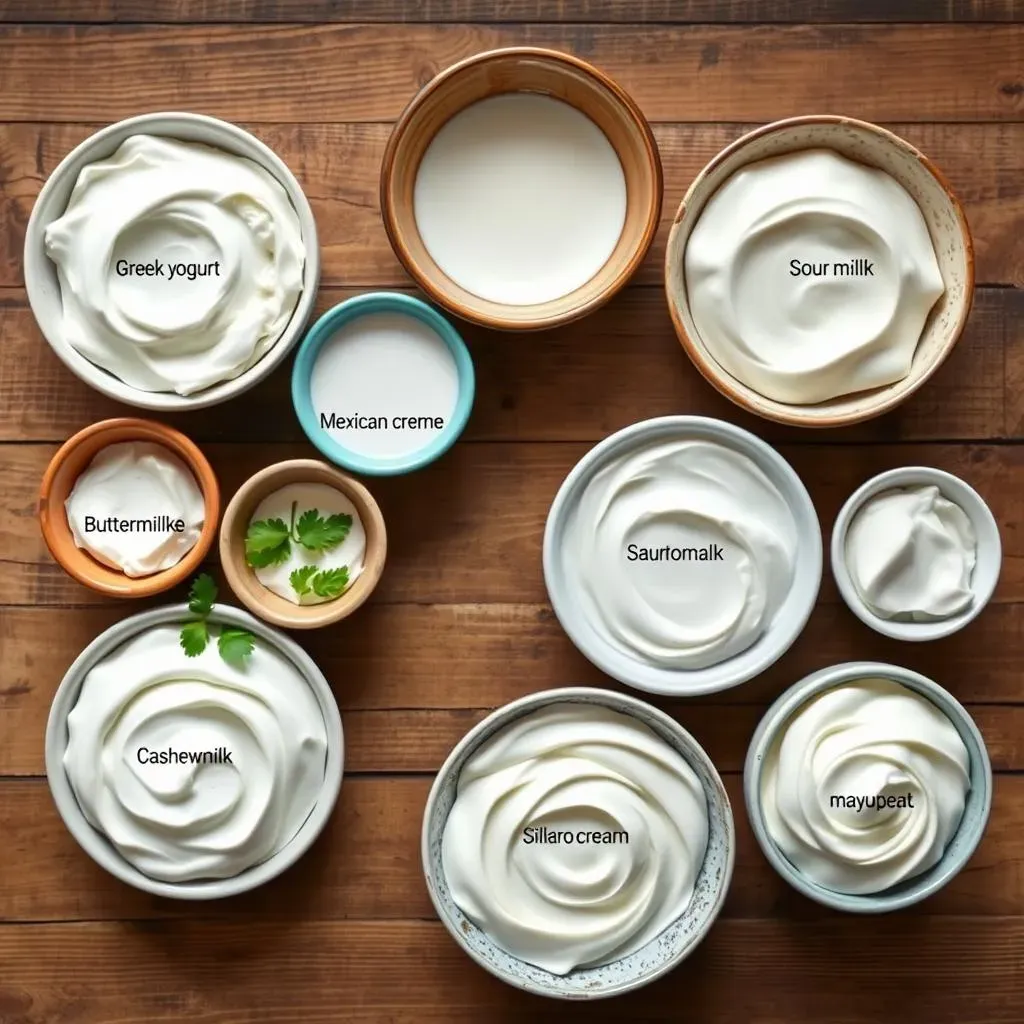Table of Contents
Ever found yourself in the middle of cooking, only to realize you're out of sour cream? It's a kitchen conundrum we all face! Sour cream is that creamy, tangy magic that adds a special touch to so many dishes, from tacos and baked potatoes to cakes and dips. But what do you do when that crucial ingredient is missing? Don't worry, your recipe isn't doomed! In this article, we're going to explore a bunch of fantastic options for "what can i substitute for sour cream", each offering a unique twist to your cooking. We'll start by understanding what makes sour cream so special and why it's used in so many recipes, then we will jump into a variety of substitutes, from dairy-based options like Greek yogurt and cream cheese to non-dairy alternatives like coconut milk and cashews. We will also cover how to use each substitute. Get ready to unlock a world of culinary creativity and never be held back by an empty tub of sour cream again!
Understanding Sour Cream and Its Role in Cooking

Understanding Sour Cream and Its Role in Cooking
What Exactly Is Sour Cream?
Let's get down to basics. Sour cream isn't just regular cream that's gone bad; it's a cultured dairy product. That means it's made by adding specific bacteria to cream, which thickens it and gives it that signature tangy flavor. Think of it like yogurt's richer, slightly more decadent cousin. It's got a higher fat content, which is why it's so wonderfully creamy and smooth. It’s that special ingredient that adds a certain oomph to many recipes.
It’s this process of fermentation that makes sour cream unique, giving it a subtle tartness that balances out richness in dishes. This isn't just a random chemical reaction; it's a carefully controlled process that creates a product with a distinct taste and texture. The bacteria are tiny little chefs working their magic to make our food taste better.
Why Do We Use Sour Cream in Cooking?
Sour cream is like a culinary Swiss Army knife; it can do a lot. It's a master of texture, adding a velvety smoothness to sauces and dips. It provides that perfect creamy base for a potato topping, or the perfect tangy element for a taco. It's also used in baking to keep cakes moist and tender. Think about that unbelievably moist chocolate cake; sour cream might be the secret ingredient you didn't know about.
Beyond texture, sour cream brings a crucial element: acidity. That tanginess cuts through richness and balances flavors. It's why a dollop of sour cream on a spicy chili or a cheesy enchilada is so satisfying. It's not just about adding creaminess; it's about creating a more complex flavor profile. It brings a certain zing that other ingredients just can’t replicate.
Sour Cream's Versatility: A Quick Look
You'll find sour cream in all sorts of recipes, and for good reason. It's a key player in both sweet and savory dishes. It can be the star of a creamy dip, the secret to a fluffy cake, or that final touch on a baked potato. Its versatility is one of the reasons we need to know what to substitute it with when it's not available.
From the simplest baked potato to the most complex layered cake, sour cream has a place. It's not just a topping or a sauce ingredient; it's a fundamental part of many recipes' structure and flavor. This is why understanding its properties is important when trying to find a substitute.
Use | Example |
|---|---|
Topping | Baked potatoes, tacos, chili |
Baking | Cakes, muffins, quick breads |
Dips & Sauces | French onion dip, creamy pasta sauces |
Top Substitutes for Sour Cream: Dairy and Beyond

Top Substitutes for Sour Cream: Dairy and Beyond
Dairy Delights: Close Cousins of Sour Cream
Okay, so you're staring into your fridge, and the sour cream container is sadly empty. No need to panic! There's a whole family of dairy options that can step in. First up, let's talk about Greek yogurt. This stuff is a powerhouse! It's thick, tangy, and can mimic sour cream in most recipes. I'd say it's the closest you can get in terms of texture and flavor. It's also packed with protein, making it a healthier choice, if that's what you are looking for. Another great option is cream cheese. Yes, the same stuff you spread on your bagels. When you whip it up with a bit of milk or water, it becomes nice and smooth, ready to replace sour cream in your dips, sauces, or baked goods. Just remember to adjust the liquid so that it has similar consistency.
Then, there's crème fraîche. This is a French staple, and it's richer and less tangy than sour cream, but it's an excellent alternative. It’s got a luxurious feel that can elevate your dishes. Mexican crema is another great choice. It’s similar to crème fraîche but has a slightly thinner consistency and a bit more tang. Both of these options bring a level of sophistication to your cooking. And if you're in a pinch, buttermilk can be used, though it's much thinner. For a thicker consistency, mix it with a bit of softened butter or cream cheese. It works well in baking and sauces, but it might not be the best for dolloping.
Substitute | Texture | Flavor | Best Use |
|---|---|---|---|
Greek Yogurt | Thick, creamy | Tangy | Dips, sauces, toppings |
Cream Cheese | Smooth, thick (when thinned) | Mild, slightly tangy | Dips, sauces, baking |
Crème Fraîche | Rich, smooth | Mild, slightly tangy | Sauces, toppings |
Mexican Crema | Slightly thin | Tangy | Toppings, sauces |
Venturing Beyond Dairy: Non-Dairy Alternatives
Now, let's explore the world of non-dairy options, because everyone deserves to enjoy a good creamy texture. If you are a vegan or have dietary restrictions, you're in luck. First up is coconut milk, but not just any coconut milk. We're talking about full-fat coconut milk, the kind you find in cans. This is a surprisingly great substitute. It's super creamy and can be used in both sweet and savory dishes. Just make sure you use the thick part from the top of the can and not the watery liquid at the bottom. Cashews are another fantastic option. When soaked and blended, they turn into a silky smooth cream that's great for dips, sauces, and even as a topping. It does require a little extra effort, but it's worth it. And for those who are always prepared, there's vegan sour cream, which is readily available in stores. It's made to mimic the taste and texture of regular sour cream, and is a convenient option.
Then there's silken tofu. Yes, tofu, that versatile protein source. When blended, it becomes smooth and creamy, perfect for sauces and dips. It’s a great way to add some protein to your meal. Lastly, mayonnaise can be used in a pinch. It's got a similar creamy texture and can work as a 1:1 replacement in most recipes. It's especially good in baked goods and dips. While it might not have the tang of sour cream, it gets the job done. You can also add a touch of lemon juice or vinegar to give it a bit of that tanginess. So, even if you're avoiding dairy, you have plenty of options to keep your recipes delicious and creamy.
- Full-fat coconut milk
- Cashew cream
- Vegan sour cream
- Silken tofu
- Mayonnaise (with a touch of lemon juice/vinegar)
How to Choose the Right Sour Cream Substitute for Your Recipe

How to Choose the Right Sour Cream Substitute for Your Recipe
Considering the Recipe's Needs
Okay, so you've got all these sour cream substitutes, but how do you pick the right one? First, think about what the sour cream is doing in the recipe. Is it adding moisture and richness to a cake? Is it providing that tangy zip to a dip? Or is it just a pretty dollop on top of your chili? For baking, you'll want a substitute that has a similar fat content and moisture level, such as Greek yogurt or cream cheese. For dips and sauces, texture and flavor are key, so options like Greek yogurt, Mexican crema, or even cashew cream could be perfect. If you're just looking for a topping, think about the flavor profile. Something milder like crème fraîche might be great for delicate flavors, while something tangier like Greek yogurt might be better for bold flavors. It’s all about matching the substitute to the role of sour cream in your recipe.
Also, consider the other ingredients in your recipe. If you're making a dish with a lot of strong flavors, you might not need a substitute that has a very pronounced flavor itself. In this case, a milder substitute like cream cheese or even mayonnaise might be a good choice. If you're making something that relies on the tang of sour cream, then Greek yogurt or Mexican crema are your best bets. Remember, you might need to do a little experimenting to find the perfect substitute for your specific recipe. It’s part of the fun of cooking, right?
Matching Texture and Flavor Profiles
Texture is a big deal when it comes to sour cream substitutes. You want to ensure that the substitute you pick has the right consistency for your dish. For example, if you're making a creamy soup, using something too thin like buttermilk might not work unless you thicken it first. On the other hand, if you're making a dressing or a sauce, you might want something with a bit more liquid, or you might need to thin it down with a bit of water or milk. Think about how the sour cream is being used in your recipe. Is it whipped into a frosting? Is it blended into a smoothie? Or is it simply a dollop on top? The texture of your substitute should match the intended use.
Flavor is just as important as texture. Sour cream has a distinctive tangy flavor, and you need to find a substitute that can mimic that. Greek yogurt is a great all-around option because it has a similar level of tanginess. However, if you're looking for something milder, cream cheese or crème fraîche might be better. If you're using a non-dairy option like coconut milk, keep in mind that it has a slightly sweet flavor, so you might need to adjust the seasoning in your recipe. Taste your substitute before adding it to the dish to make sure it's the right flavor profile for what you're making. Don't be afraid to experiment and find what works best for you.
Substitute | Ideal Texture | Ideal Flavor |
|---|---|---|
Greek Yogurt | Thick, creamy | Tangy |
Cream Cheese | Smooth, thick (when thinned) | Mild, slightly tangy |
Crème Fraîche | Rich, smooth | Mild, slightly tangy |
Coconut Milk | Thick, creamy | Slightly sweet |
Cashew Cream | Silky, smooth | Mild, nutty |
Adjusting and Experimenting
Okay, so you've picked your substitute, but don't be afraid to adjust it as needed. If your substitute is too thick, thin it out with a bit of milk or water. If it's not tangy enough, add a squeeze of lemon juice or a splash of vinegar. Taste as you go and don't be afraid to experiment. Cooking is a journey, not a destination. Sometimes, the best results come from a little bit of trial and error. If you're not sure about a substitute, start with a small amount and see how it works in your recipe. You can always add more later. Remember, there's no one-size-fits-all solution, so feel free to get creative and find what works best for you.
And if you're using a non-dairy option, keep in mind that it might not behave exactly like dairy. Coconut milk, for example, can sometimes separate when heated, so you might need to whisk it vigorously before adding it to your recipe. Cashew cream can sometimes be a bit too thick, so you might need to thin it out with a bit of water. The key is to be flexible and adapt to the unique characteristics of each substitute. The more you experiment, the better you'll become at choosing the right substitute for every recipe. And who knows, you might even discover a new favorite along the way!